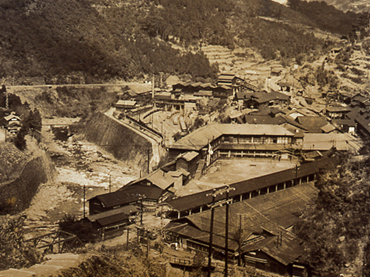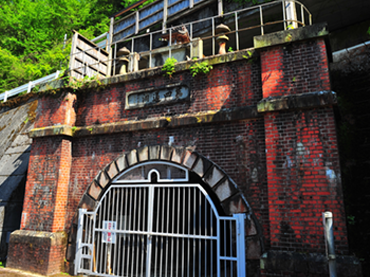Upon completion of Adit No. 4, the Mine Headquarters was relocated in 1916 from Toen (at an altitude of 1,150 meters) in Kyubesshi near the mountain peak to Tonaru (at an altitude of 760 meters) on the mountainside. At that time, the center of gravity of mining operations had already started to shift to Tonaru and the opening of Adit No. 4 made it clear that Hadeba, at a far lower altitude than Tonaru, was where the action would be from now on. Therefore, taking this opportunity, a decision was made to concentrate the functions of Besshi Mine at Hadeba. In line with this relocation, miners who lived in Kyubesshi moved to Tonaru or Hadeba. Branches of the departments at Kyubesshi were abolished and everything was relocated apart from certain facilities of the Forestry Department and the Brewery Department.
On the other hand, Hadeba developed rapidly from then on. In 1917, company housing was built in Uchiyoke and Shikamori, and the Shikamori Branch of the Sobiraki Elementary School/Junior High School (a private school established by Sumitomo), the Hadeba Clinic of the Sumitomo Hospital (private hospital), and other facilities necessary for everyday life were established. Upon completion of the ore sorting yard in Hadeba in 1927, ore, which under the previous system would have been transported to Tonaru, were concentrated at Hadeba. Upon relocation of the Mine Headquarters to Hadeba in 1930, the ore sorting yard in Tonaru was closed. In line with the concentration of the mining business in Hadeba, it became the center of the Besshi Copper Mines.
Subsequently, mining at Besshi encountered difficulties owing to unrealistically high production targets during the Second World War. However, from 1955 onward, buoyed by the post-war recovery, production at Besshi recovered to the level before the end of the war. Moreover, a large inclined shaft from Hadeba to a gallery 1,000 meters below sea level was completed in 1968 and entered full-scale operation in January 1969.
However, with the temperature hitting 50 degrees centigrade and humidity exceeding 95%, production efficiency at the deepest area of the shaft remained low. In addition, there was a risk of rock bursts owing to the pressure of the bedrock. The deeper the excavation, the lower the copper content of the ore. The Besshi Copper Mines were reaching their limits in terms of ore grade, ore quantity, and working environment. Furthermore, with a rising tide of low-cost imports of copper ore heading for Japan, Sumitomo decided to close the Besshi Copper Mines. The 293 years of the history of the Besshi Copper Mines ended in 1973.
Nowadays, Hadeba is managed by Minetopia-Besshi as a cluster of industrial heritage sites in the Hadeba Zone open to the public. Among the numerous points of interest are Adit No. 4, Hadeba Hydroelectric Power Plant, the remains of the ore storehouse, the iron bridge on the lower railway, the water channel, the large inclined shaft, and the remains of company housing. All serve to remind visitors of Hadeba’s former prosperity.

 EN
EN


















